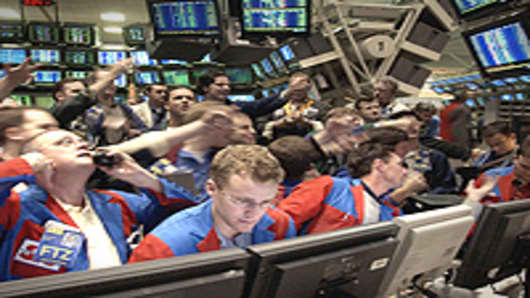Despite the surprise success of Thursday's 30-year bond auction, analysts think the outlook for Treasurys is anything but bullish—prices will continue to decline, pushing interest rates higher.
The reason, most bond pros believe, is that economic signs are getting better, inflation threats are accelerating and the government keeps issuing more debt.
"The bias will be for higher rates," says Kim Rupert, managing director of global fixed income analysis at Action Economics in San Francisco. "It's not going to be a straight line. We're going to see dips in yield like we're seeing today."
Thursday's auction showed just how fickle the market has been lately, with a sale of 30-year bonds generating much more interest than anticipateddespite two shorter-duration auctions drawing middling bids earlier in the week. Beaten-down prices from this week's accelerated drop likely brought some investors off the sidelines.
The yield on the 10-year Treasury gained a quarter percentage point this week before easing Thursday, a move bond pros attribute to the opposing factors of improving economic data and fears of ballooning government deficits and inflation.
Yields rise and prices drop when investors sell bonds, which can happen for a number of reasons. Economic strength can drive investors out of bonds and into riskier assets like stocks, while inflation fears and high debt issuance also can trigger bond selling when investors worry that the value of their fixed-income investments will be eroded.
Both factors have been present this week.
"The move in yields is an amalgamation of a number of factors," says Jessica Hoversen, fixed income analyst at MF Global in Chicago. "Economic growth factored into this. The data has been undeniably better, suggesting that the economy is continuing to recover."
Concerns from inflation also pushed down prices, with traders worried that huge debts and deficits will drive interest rates higher and erode the value of bonds. Those fears were heightened on news that President Obama and congressional Republicans had reached a deal on extending Bush-era tax cuts, as well as unemployment benefits, without proposing corresponding cuts in spending.
"Everyone talks about higher asset price inflation, how the Fed is trying to trigger that," Hoversen says. "For a while they were able to do that with equities. Now the problem is, what if they just trigger it in commodities and it moves into consumer prices?"
Supporters of the Fed's policies to buy Treasurys and drive down rates have said the Fed and its chairman, Ben Bernanke, can simply reverse course and tighten monetary policy should inflation get out of control.
Not everyone in the market is buying that premise, however.
"The erosion in longer-dated Treasurys (prices) indicates there is some fear that despite Bernanke's confidence that the Fed can hike rates appropriately, the market knows that history suggests the fed is slow at restraining inflation," Rupert says
That fear showed up in this week's earlier auctions of three- and 10-year notes. The sales were far from disastrous but showed that the market is approaching a point where it can no longer absorb the current barrage of debt without getting greater return.
The big demand from Thursday's sale was not completely unexpected seeing how fast and how far prices had dropped in the previous trading sessions this week, enticing bargain hunters
Since the Fed undertook its latest round of Treasury guying—"quantitative easing," or QE2 in market parlance—Credit Suisse has reduced its exposure to Treasurys.
Analyst Andrew Garthwaite, in a cautionary but not alarmist research note to clients, forecast the near-term yield for the 10-year note at 3.5 percent but probably not hitting 4 percent.
He based his caution on the supply with QE2, and his supportive statements on the notion that the Fed won't be raising rates anytime soon and banks are likely to keep accumulating Treasurys, possibly hitting 20 percent of their assets and matching the historic peak in 1994.
Further, fund flows have shown money moving out of bonds and into equities, he wrote.
"This pattern of funds flow suggests that investors want to be cautious...but realize that bonds carry a risk...and that, at the margin, some types of equities are safer than bonds," Garthwaite said.
Hoversen said there's resistance for the 10-year yield at 3.36 percent and support at 3.17, while Rupert put the range at 3.50 and 2.90 respectively. Those projections represent a belief that investors will begin to leave Treasurys but are unlikely to stampede.
"For individual investors you've got to be very careful in the Treasury market right now. If you're looking for income, there's some buying opportunities but you've got to pay attention," says Bill Walsh, president of Hennion & Walsh in Parsippany, N.J. "You're going to see trading in this type of range, depending on the stock market and the economy."



